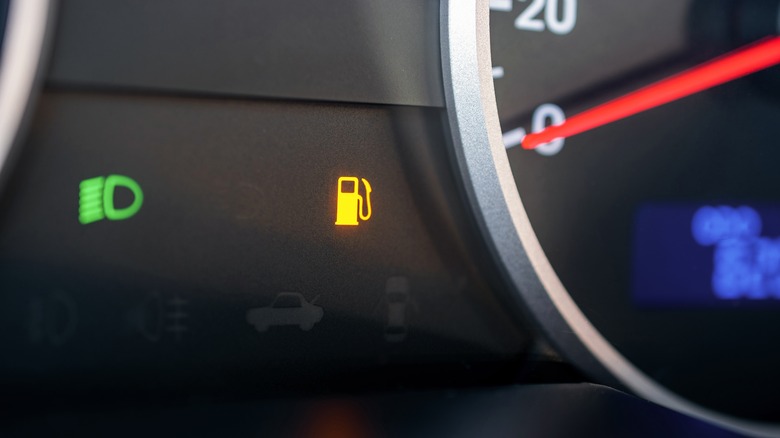How Many Miles Can You Drive Once The Gas Light Turns On?
Running out of gas is one of the biggest headaches when it comes to driving a car. Being stuck on the side of the road and walking to the nearest gas station is embarrassing, and it always happens at the worst time. While most cars track how many miles you have left, the number can be inconsistent, and eventually, even that turns off. So, how long can you drive once your gas light turns on?
Unfortunately, given how many different vehicles are on the road, it's hard to give an exact number. Numerous factors determine how many miles you can drive when your gas light turns on, including the car's make and model, the weather conditions, and your habits as a driver. However, according to NAPA, a safe rule to follow is that you have between 30 and 50 miles in the tank once your gas light comes on, but you should always aim for the lower end of that range. AAA, which's towed countless gas-less cars on the side of the road, corroborates the estimate, saying the 30 to 50-mile range is safe for most cars, noting that larger vehicles drive up to 80 miles.
So, while you can likely go a fair distance with your gas light on, you should always strive to fill up and avoid the situation. (But don't top off your gas tank because that's a huge mistake.)
Why you should avoid driving on empty
There's no shortage of embarrassment when you run out of gas, and that anxiety ensures most drivers won't ever find themselves in that situation — it even branched into the electric vehicle industry with range anxiety. However, outside of sheer embarrassment, there's another reason why you should avoid driving with your gas light on.
You may not know that regularly driving on an empty or nearly empty tank can damage your fuel pump. Over time, debris, gunk, and even rust can accumulate at the bottom of your gas tank. While that isn't inherently an issue, when you drive on an empty tank (with your gas light on), your car's fuel pump can dip into this gunk. And if it ends up sucking up some of the debris, the fuel pump could need replacing, and your car can't function without its fuel pump.
If that wasn't bad enough, driving with your gas light on could also harm your engine. The fuel pump runs gas through the engine. So, if it's sucking up gunk instead of gas, it will pump dirt, debris, and other nonsense through your engine instead. This could lead to an onslaught of issues in the engine, impacting its overall performance and longevity. So, while the gas light is a great reminder when it's time to fill up, you should always strive to maintain a healthy amount of fuel in your car.

